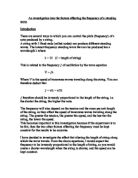Fair test:
To try and keep this experiment fair the only equipment that will be changed is the ones that control the two variables – the signal generator controlling the frequency and the position of the tube controlling the length.
Prediction:
I predict that the results collected will fit with my current knowledge of standing waves.
L = (2n-1) λ / 4
f = v / 4L
Results:
F is the frequency output from the signal generator and the speaker. 1/f is the time of one wavelength.
λ is the wavelength. This was calculated by v*1/f where v is the speed of sound. This was accurately adjusted to the air temperature (because sounds speed changes in different temperatures) with v= 331.5+(0.6*T) T is the room temperature in °C which in this case was 21.5°C which makes the speed of sound 344.4.
L=(λ/4)-d is the length calculated with a formula designed for use with tubes where d is the diameter of the tube, 0.025m in this case.
L=(λ/4) is the length calculated with the standard formula for standing waves caused by being bounced off a surface.
L is the measured tube length.
Conclusion:
As expected the measured results fit well with the existing rules of standing waves.
from s-cool.co.uk
This diagram shows a standing wave. The x points are nodes where the waves add up to zero and the y points are antinodes where the waves combine to give a large oscillation.
The fundamental note is reached in a tube when there is just one node as this diagram shows:
This creates the lowest possible resonance. With just one node in the tube only ¼ of the wavelength is in the tube. This brings us to the formula L = (2n-1) λ/4 because for every extra node in the tube there is an extra half a wavelength.
For just looking at the fundamental note however, we only need the formula L = λ/4 or the alternative L = λ/4 – d
My measured results prove this to be correct. Both my graphs show the measured results between the two calculated ones, although it is hard to define which it is closer to.
Also the speed of sound can be calculated from the length of the tube and the frequency at a fundamental note because f = v/ λ and λ= 4L so v = f*4L.
Evaluation:
There are a few points in this experiment that may make it inaccurate. Most of these are in the measuring of the results.
Firstly the measuring of the length of the tube was done with a ruler by hand. This can result in human error and also the apparatus is only accurate down to a mm. To improve this the measurement marks could be marked on the tube to reduce the risk of human error and a flat piston inside the tube could be used instead of water because its more accurate than the surface of water.
Also there was a reliance on the human ear to detect where the fundamental note was. This is a very inaccurate way of detecting it because it isn’t that sensitive compared to electronic equipment. It would be better to instead use a microphone connected to an oscilloscope to be able to accurately visually check where the fundamental note is.
The other inaccuracy is in the control of the environment around the experiment. It would be better to do the investigation in a controlled area where the temperature is guaranteed to remain constant and thus the speed of sound.
Also the use of water as a reflective surface may cause unknown affects as it is able to move. There is a chance that some of the sound waves can be absorbed by it and the vibrations caused by the oscillations in the tube when standing waves occur could cause ripples on the water which would in turn affect how the sound wave reflects off the water. It would be better to instead use a solid surface.









